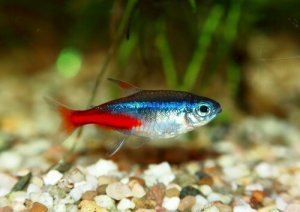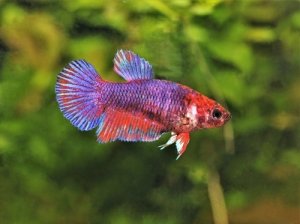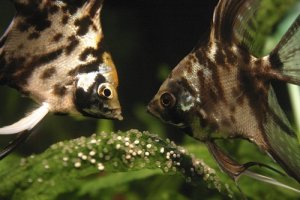
Although they are an easy kind of fish to breed, if you want to get Zebra Danio eggs fertilized it helps to understand common mistakes, troubleshooting, and the environment these fish need for breeding. Although they are hardy and many fishkeepers report finding eggs in their tank without doing anything, the more you understand about your fish, the better.
So, read on for a breakdown of what can prevent your Zebra Danio eggs from being fertilized, as well as more info on eggs and milt such as what to do if you find them in your tank, female Zebra Danio pregnancy, and more.
How To Spot Zebra Danio Eggs In Your Tank
Spotting Zebra Danio eggs may be tantalizing if it is the first time breeding your fish and you are worried that they won’t spawn. However, rest assured that if your fish lay eggs, it’s easy to know about. Fish eggs are unmistakable clusters of small spheres that cling to the side of the tank glass or to the underside of plants and leaves, or alternatively, you will see them nestled amongst foliage near the stalk of your plants.
Zebra Danios need to feel safe in order to spawn, so look in the spots where you know your fish enjoy hanging out, and there is plenty of cover. Zebra Danio fish reach sexual maturity at 4 months but live any duration from 2-5 years, so there is plenty of opportunity to breed them. These fish are easy to breed, and if you try, you may soon see a cluster of tiny Zebra Danio eggs.
How To Tell If Zebra Danio Eggs Are Fertilized Or Unfertilized?
Even if there are eggs in your tank, this may not necessarily indicate that they are fertilized. As a rule of thumb, fertilized Zebra Danio eggs are yellow, whereas unfertilized ones are white.
However, timing is also a useful way of telling whether eggs are fertilized. Zebra Danio eggs do not take long to hatch at all. In fact, the average duration is about 2-4 days, with 5 as a relative maximum. So, if your eggs have not hatched in this time, it’s safe to say they didn’t get fertilized.
What Do Zebra Danio Eggs Look Like?
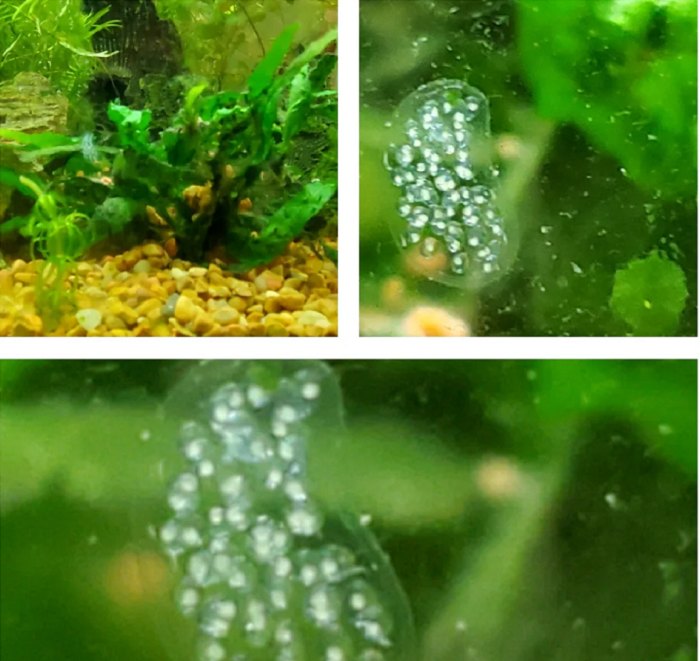
So, we’ve established how to spot Zebra Danio eggs. Now you know that they look like small, yellow or white balls, it means you won’t mistake them for run-of-the-mill slime, dirt, algae, or some sort of toxin.
However, you may have a community tank, and wonder ‘what do Zebra Danio eggs look like?’ compared with other fish eggs. This can be especially tricky if you have multiple small species of schooling fish, for example, in an aquascape tank, such as rasboras and tetras. Read on to find out some common look-alike fish eggs.
Common Misidentifications – Other Fish Eggs That Look Like Zebra Danio Eggs
- Snail Eggs
Snail eggs can be confusing as they look very similar to fish eggs. There are a variety of common snails that are used in aquaria and all of these lay eggs. However, the key to telling them apart from Danio eggs is that only Danio eggs turn yellow when fertilized.
Snail eggs may occasionally turn a milky pink or blue, or start off as this color. However, the majority of them just remain white. Therefore, you may mistake them for unfertilized Zebra Danio eggs if you have both in your tank. However, you will never mistake them for fertilized Zebra Danio eggs.
- Rasbora Eggs
Rasboras are a large family of schooling and shoaling fish that sometimes come from similar places as the Zebra Danio. Fortunately, it’s easy to be able to tell Rasbora and Zebra Danio eggs apart as most Rasbora eggs remain clear regardless of whether they are or aren’t fertilized.
Therefore, it’s possible to tell if Rasbora eggs are fertilized by looking for little black dots inside them that indicate the growing fish fry. However, you won’t ever mistake them for Zebra Danio eggs which can be translucent when the female first lays them but quickly turn white or yellow depending on whether they are fertilized or unfertilized.
- Tetra Eggs
There are many varieties of Tetra, but they all lay relatively similar eggs. Just like the process of telling Zebra Danio eggs and snail eggs apart, you may mistake Danio eggs for Tetra eggs or vice versa. However, as with snail eggs, it is only the Zebra Danio eggs that turn yellow when fertilized.
How Many Eggs Do Zebra Danios Lay In One Go?
Zebra Danios lay anything from 200-300 eggs in one go. This may sound like a lot, but in their natural habitat, it makes lots of sense from a survival perspective.
For example, not all of the eggs will get fertilized. This is something you can most likely observe in your own tank, as only some of the eggs will hatch, and only some of them will change from white to yellow (indicating fertilization).
Something that you may not observe as often at home is predation. Zebra Danios, as small fish, are near the bottom of the food chain in the wild, and not only will many fish eat their own eggs, but other species may also eat Zebra Danio eggs, not to mention the fry as they grow up.
As a result of all the dangers facing a single Zebra Danio fry as it starts its journey as an egg and grows into an adult fish, it makes sense for them to lay a lot of eggs, as statistically, that way, some will definitely survive to adulthood even if others get eaten.
Where Do Zebra Danios Lay Their Eggs?
As mentioned above, Zebra Danios lay their eggs anywhere that is secluded and secure, such as amongst a mass of plants, or near rocks or driftwood. However, in an artificial aquarium environment that is free from predators, they may lay their eggs on the side of the glass. In this instance, you may wonder whether they are snail eggs.
What To Do With Unfertilized Zebra Danio Eggs
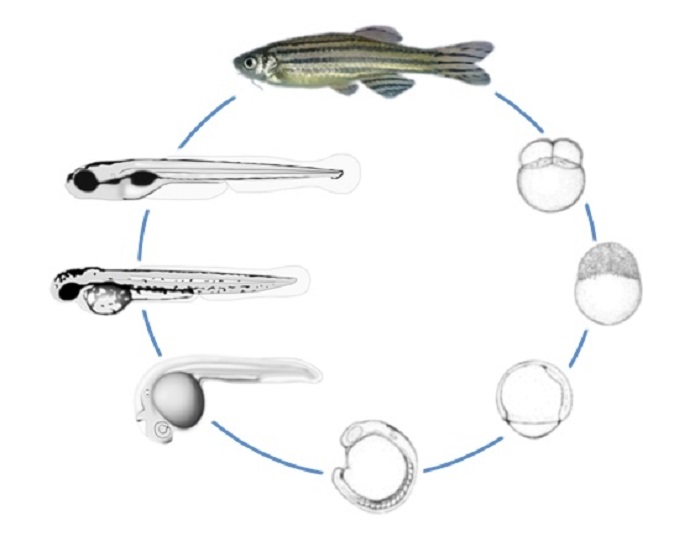
In an aquarium setting it may be tricky to know what to do with unfertilized Zebra Danio eggs, but remember that in the wild, everything forms a part of the ecosystem. Generally, unfertilized fish eggs tend to get eaten by other creatures. But what about in your tank?
Should I Just Throw Unfertilised Eggs Away?
You may think you need to throw unfertilized Zebra Danio eggs away, but in fact, it’s generally best to leave them in the tank. Zebra Danios will eat their eggs if given the chance and if they need the nutrients.
There are some commercial products you can put into your tank water to dissolve the eggs if needed. But many aquarists do not recommend this. It simply adds to the amount of chemicals in your tank, is irreversible, and deprives your fish of a valuable source of nutritious protein.
Can I Fertilize Unfertilized Zebra Danio Eggs?
Short of simply setting up the tank to ensure all the conditions are met, there’s not much you can manually do to fertilize Zebra Danio eggs, or any fish eggs for that matter.
Breeding fish is a deceptively simple process. It is often easy to encourage, but it’s hard for humans to intervene without the sorts of chemicals and equipment found on commercial fish farms. Thus, it’s best to just get the conditions right in the first place.
How Can I Tell What Went Wrong With Breeding My Zebra Danios?
If you’re struggling to get your Zebra Danio eggs fertilized, or struggling to breed your fish in the first place, there are a number of simple reasons why this could be. Once you know what they are, it’s easy to check your tank conditions and parameters, and see which things might need changing
- No temperature change
Did you know that Zebra Danios need a temperature drop to initiate spawning? This is because spawning in Zebra Danios is dependent on the sun. In their natural habitat of slow-moving rivers and streams in India and Bangladesh, the early morning chill and subsequent sunlight will kick off the spawning process when it is breeding season.
You can mimic this in your tank by lowering the temperature by a few degrees in the early morning of the day you want your fish to spawn. An ideal temperature for these fish is anything roughly between 65-74 F or (18-23 C) however this temperature dip is mostly relative. Thus if your fish are happy at 72 F (22 C), lowering the temperature to 70 F (21 C) is likely to initiate the process.
- Lighting was wrong
As these spawning triggers would have come from the sun in the wild, lighting is also a factor in the spawning process. If there are eggs in your tank and the male has not fertilized them, try turning tank lights off at night if you don’t already, or introducing the container with your fish to a darker place.
- Fish don’t feel safe in the tank
If fish don’t feel safe in the tank, it’s very unlikely that they will spawn successfully. For male Zebra Danio fish, the presence of other males can indicate competition for a male. That’s why sometimes it’s a good idea to isolate pairs in a separate tank, container, or breeding box.
Alternatively, if you are trying to get eggs fertilized in your main community tank and they are attracting the attention of predatory tank mates, your male may not want to approach them to spray his milt. The best tankmates for Zebra Danios are relatively peaceful and non-predatory.
- Fish were stressed for other reasons
Fish can also get stressed for other reasons. For example, if they are sick from poor water quality, or you are trying to breed your fish in a tank that is overcrowded. Fish can even get stressed from external factors like the presence of a neighborhood cat.
- Fish didn’t get enough nutrition
If male Zebra Danios do not get enough nutrition, it’s unlikely that they will want to mate. Indicators of this can include lethargy and unwillingness to eat the food (indicating they aren’t enjoying it or it isn’t good for them, or could even be making them bloated or sick).
Even though flake and pellet foods are marketed as being ‘complete’, your fish actually need a much more varied diet in order to fully thrive. Remember, if fish are properly thriving, they will be more likely to mate.
You can enrich your male Zebra Danios’ diet with free swimming live protein like daphnia or brine shrimps, or alternatively, you can purchase these in frozen form from most aquatics stores.
- Male and female are not interested in each other
Sometimes, the fish just aren’t interested in each other! This can happen, and it may be that the female is receptive to mating, having laid her eggs, but the male doesn’t reciprocate. In this instance, if you’ve ruled out everything else, there’s not much you can do. You can occasionally try introducing another male. However, this also doesn’t guarantee fertilization, especially as these fish are known to release eggs specifically for each mate.
- Your fish are sick
Lastly, it’s a sad fact that some commercially bred fish, especially species like the Zebra Danio that are very popular, are often badly bred or inbred. This can happen with unscrupulous breeders, so always be sure that you have sourced your fish from a reputable source. Many mainstream aquatics stores are fine.
However, when purchasing fish, take a look at the conditions they are kept in and how healthy they look. Are the tanks overcrowded? This will give you a good idea of whether they have been cared for well in general, and whether you will have problems down the line.
Bottom Line
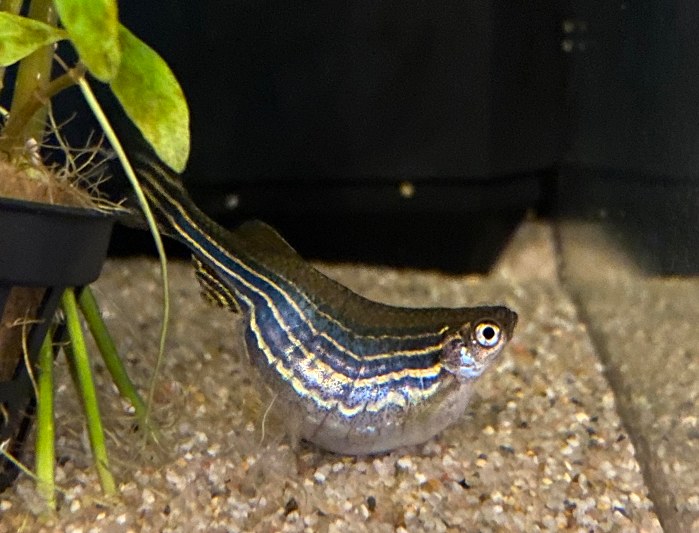
Breeding fish may seem like it is hit-and-miss, but in reality, it’s about mimicking the natural conditions in which they spawn in the wild. If you did not successfully breed fish the first time, or your male failed to fertilize the eggs, don’t worry. Zebra Danios breed easily, and there will always be another chance.
Either way, gaining hands-on experience with breeding fish is a great skill for any aquarium keeper and can lead to lots of success in the future, as well as help you get more in tune with your fish’s behavior and needs.


